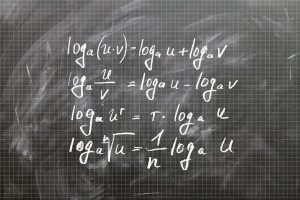 Exponents are one of the more frequently tested concepts on the GMAT. It’s likely that you learned all the exponent formulas that you’ll need for the GMAT way back in middle and early high school math, so you’re probably overdue for a refresher! And even if you consider yourself an “exponent expert,” you’re going to have to apply your knowledge of exponents in extremely particular ways on the GMAT, as exponents can appear in a wide variety of question types and are often combined with other mathematical concepts.
Exponents are one of the more frequently tested concepts on the GMAT. It’s likely that you learned all the exponent formulas that you’ll need for the GMAT way back in middle and early high school math, so you’re probably overdue for a refresher! And even if you consider yourself an “exponent expert,” you’re going to have to apply your knowledge of exponents in extremely particular ways on the GMAT, as exponents can appear in a wide variety of question types and are often combined with other mathematical concepts.
Luckily, we’ve done the hard work of distilling everything you need to know about GMAT exponents! In this post, we’ll cover all the relevant rules, properties, formulas, and shortcuts. We’ll also walk you through an example of every main kind of exponent question that you’ll encounter on the test, so you can see these formulas in action. By the end, you really will be an exponent expert!
What Are Exponents? Definitions and Terminology
Below are the basic definitions and terms that you need to know for GMAT exponents. Most of this is probably very familiar to you, but make sure you understand everything before moving on.
Definition of Exponents
Let’s start with the basics. An exponent indicates how many times a given number should be multiplied by itself. The number itself is called the base number, and for any base number $k$, the exponent $n$ says how many times to use that number in a multiplication. The exponent is written in superscript to the right of the base number:
$$k^n$$
We’re most familiar with the “square,” which is what it’s called when the exponent is 2.
Not sure how or what to study? Confused by how to improve your score in the shortest time possible? We've created the only Online GMAT Prep Program that identifies your strengths and weaknesses, customizes a study plan, coaches you through lessons and quizzes, and adapts your study plan as you improve.
We believe PrepScholar GMAT is the best GMAT prep program available, especially if you find it hard to organize your study schedule and don't want to spend a ton of money on the other companies' one-size-fits-all study plans.

$$k^2 = k × k$$
But an exponent can be any number. Here are some basic examples:
$$2^2 = 2 × 2 = 4$$
$$3^2 = 3 × 3 = 9$$
$$4^2 = 4 × 4 = 16$$
$$5^2 = 5 × 5 = 25$$
$$2^3 = 2 × 2 × 2 = 8$$
$$3^3 = 3 × 3 × 3 = 27$$
$$4^3 = 4 × 4 × 4 = 64$$
$$2^4 = 2 × 2 × 2 × 2 = 16$$
$$3^4 = 3 × 3 × 3 × 3 = 81$$
$$4^4 = 4 × 4 × 4 × 4 = 256$$
$$5^4 = 5 × 5 × 5 × 5 = 625$$
Another common term for exponents is “powers.” We can refer to $k^n$ as “the $n$th power of $k$,” or “$k$ to the power of $n$.” Raising any number to the power of 2 is called squaring that number, and raising the number to the power of 3 is called cubing the number.

Definition of Roots
The square root of any number $y$ is a number that, when squared, equals $y$. (If $y = k^2$, then $k$ is the square root of $y$.)
The same goes for the cube root: the cube root of any number $y$ is a number that, when cubed, equals $y$.
And so on for every exponent.
The square root of any number is represented by this symbol, called a “radical”:
$$√4 = 2$$
$$√25 = 5$$
Any root beyond a square root (cube roots and up) is represented by a little number in superscript to the left of the radical that indicates the power. Below are examples of cube roots:
$$√^3{8} = 2$$
$$√^3{125} = 5$$

Properties of Exponents
Now that we’ve reviewed the definitions, let’s get into the properties of exponents that you need to know for the GMAT.
Property of the Exponent 1
Any number to the power of 1 is just itself, which is why you don’t really see numbers with exponents of 1 next to them, as it just isn’t necessary.
$$2^1 = 2$$
$$8^1 = 8$$
$$5093^1 = 5093$$
Property of the Exponent 0
Any number to the power of 0 is 1:
$$2^0 = 1$$
$$5^0 = 1$$
$$217^0 = 1$$
$$509395934234^0 = 1$$
Squaring a Number Between 0 and 1
As you can see from the examples above, when you square (or raise to any higher power than 2) a base number that is greater than 1, the result will be a larger number.
Want to improve your GMAT score by 60 points?
We have the industry's leading GMAT prep program. Built by Harvard, MIT, Stanford, and Wharton alumni and GMAT 99th percentile scorers, the program learns your strengths and weaknesses and customizes a curriculum so you get the most effective prep possible.

When you square (or raise to any higher power than 2) a base number that is between 0 and 1, the result will be a smaller number. Here’s an example:
$$(1/2)^2 =1/4$$
$$1/4 < 1/2$$

Positive and Negative Powers
Positive and negative powers and their roots have particular properties.
Every Positive Number Has Two Square Roots
Every positive number has two square roots: the positive square root, and the negative square root. This is because a negative multiplied by a negative is a positive. Here’s an example:
$$√4 = 2 (-2)$$
$$2 × 2 = 4$$
$$(-2) × (-2) = 4$$
Cubes and Other Odd Powers Have Only One Real Root
Cubes, on the other hand, have only one real root, because a negative times a negative times a negative equals a negative, and a positive times a positive times a positive equals a positive.
$$√^3{8} = 2$$
$$2^3 = 8$$
$$√^3{-8} = -2$$
$$(-2)^3 = -8$$
Odd powers will always have the same sign as their roots.
Negative Squares
The square root of a negative number is not a real number.
$√(-9)$ = not a real number
This applies to all even powers ($x^2$, $x^4$, $x^6$…and so on)
Negative Exponents
Any base number to a negative power equals 1 divided by the base number to the positive version of the exponent:
x-r = 1/xr , where $r$ is any positive integer and $x$ is any positive number.
$$5^(-2) = 1/(5^2) = 1/25$$

Want to Identify YOUR GMAT Strengths and Weaknesses?
Our proprietary GMAT Diagnostic Assessment creates a customized study plan for you that takes you from registration all the way to test day! It is included with every account and proven to significantly maximize your score.
Get your personalized assessment as part of your 5 day risk-free trial now:

Fractional Exponents
Fractional exponents look tricky at first. Here are all the equivalencies ($x$ is any positive number and $r$ and $s$ are any positive integers):
$$x^{r/s} = (x^{1/s})^r = (x^r)^{1/s} = √^s{r}$$
The two middle steps here simply illustrate the ‘exponent to the power of another exponent’ rule; the most important thing to remember is that xr/s = s√(xr). Let’s see this in action:
$$27^{2/3} = (27^{1/3})^2 = (27^2)^{1/3} =√^3{27^2} = √^3{729} = 9$$
$$8^{1/3} =√^3{8} = 2$$
$$9^{1/2} = √9 = 3$$
So any number to the power of $(1/2)$ is just the square root of that number, and any number to the power of $1/3$ is just the cube root, and so on.
The Cyclicity Property
Successive powers have what’s called a “cyclicity” that manifests in the units digit. Take 3, for example:
$$3^1 = 3$$
$$3^2 = 9$$
$$3^3 = 27$$
$$3^4 = 81$$
$$3^5 = 243$$
$$3^6 = 729$$
Pay attention to the units digits. Notice a pattern? The last digit repeats itself after a cycle of 4, and the cycle is 3, 9, 7, 1.
This repetition of numbers after a particular stage is called the cyclicity of numbers. This comes in handy when you need to find the unit digit of a given number to a certain power on a GMAT question, as you just need to find the number on which the cycle stops.

Rules for Manipulating Exponents
Below are the rules for doing algebra and arithmetic with exponents that you’ll need to know for GMAT exponent questions.
Multiplying and Dividing With Exponents
Below are the rules for multiplying and dividing with exponents. Note: You can’t combine bases or exponents when adding or subtracting terms—the algebraic equivalents are much more complex. Which is why we’re jumping first into multiplication and division!
Multiplying and Dividing with Same Base, Different Exponents
If you have to multiply two values together that have the same base number but different exponents, you can simply add the exponents together. Here’s an example:
$$3^2 × 3^5 = 3^(2+5) = 3^7 = 2187$$
Algebraically, this rule is represented as follows:
$$x^r × x^s = x^(r+s)$$
where $x$ is any positive number and $r$ and $s$ are any real numbers.
This division rule is the opposite of the rule above. If you have to divide two values together that have the same base number but different exponents, you can simply subtract the exponent of the denominator from the exponent of the numerator:
$${x^r}/{x^s} = x^(r-s)$$
where $x$ is any positive number and $r$ and $s$ are any real numbers. Here’s an example:
$$4^5/4^2 = 4^(5-2) = 4^3 = 64$$
Multiplying and Dividing with Different Bases, Same Exponent
If you have to multiply numbers with the different base numbers but the same exponent, you simply multiply the base numbers and keep the exponent as it is:
$$x^r × y^r = (xy)^r$$
where $x$ and $y$ are any positive numbers and $r$ is any real number. Here’s an example
$$3^2 × 5^2 = (3 × 5)^2 = 15^2 = 225$$
For division, the opposite rule applies. A fraction to any positive power equals the numerator to that power divided by the denominator to that power:
$$(x/y)^r = {x^r}/{y^r}$$
where $x$ and $y$ are any positive numbers and $r$ is a real number.
$$(3/4)^2 = {3^2}/{4^2} = 9/16$$

Exponents Raised to Another Power
Exponents can be layered, like in this example:
$$(4^2)^3$$
When you have a value with an exponent raised to the power of another exponent like this, you simply multiply the two exponents:
$$(4^2)^3 = 4^(2×3) = 4^6 = 4096$$
In general terms, we can write the rule as such:
$$(x^r)^s = x^{rs}$$
where $x$ is a positive number and $r$ and $s$ are real numbers.
Simplifying Exponents and Base Numbers With Factors
Base numbers that are already squares, cubes, etc of other numbers can be simplified. To use the square root as a base number, you multiply the exponent by 2 to get an equivalent expression. Here’s an example:
$$4^14 = (2^2)^14 = 2^28$$
For the cube root, you’d multiply the exponent by 3:
$$8^7 = 2^21$$
And so on for all the powers.

GMAT Exponent Practice Problems
Below are examples of the key kinds of GMAT exponent questions you will encounter on the exam, including data sufficiency and problem solving varieties.
GMAT Exponent Question 1: Exponents and Cyclicity
If $a$ and $b$ are positive integers and $x = 4a$ and $y = 9b$, which of the following is a possible units digit of $xy$?
(A) 1
(B) 4
(C) 5
(D) 7
(E) 8
This question is simpler than it looks! We just need to find the cyclicity of powers of 4 and powers of 9. One thing you can do is plug in number values for $a$ and $b$, starting with 1 for each. Let’s do $a$ first:
If $a$ = 1, $x$ = 41 = 4
If $a$ = 2, $x$ = 42 = 16
If $a$ = 3, $x$ = 43 = 64
If $a$ = 4, $x$ = 44 = 256
…Notice a pattern yet? There is a cycle of 2: the units digits for powers of 4 is either 6 or 4.
Now let’s do $b$:
If $b$ = 1, $y$ = 91 = 9
If $b$ = 2, $y$ = 92 = 81
If $b$ = 3, $y$ = 93 = 729
If $b$ = 4, $y$ = 94 = 6561
The units digits for powers of 9 is either 9 or 1, so there’s also a cyclicity of 2.
Now, let’s multiply the possibilities of units digits for $x$ with the possibility of units digits for $y$. A cycle of 2 possibilities times a cycle of 2 other possibilities = 4 possible combinations: (4×9), (4×1), (6×9), and (6×1)
$$4 × 9 = 36$$
$$4 × 1 = 4$$
$$6 × 9 = 54$$
$$6 × 1 = 6$$
So we’re looking for either 6 or 4. (B) is the answer.
GMAT Exponent Question 2: Exponents, Cyclicity and Remainders
Cyclicity is a concept that comes up a lot on the more challenging GMAT exponent questions, so we’ve included another example. Unlike the last question, this one doesn’t ask directly about units digits, which makes it even tougher!
If $n$ is a positive integer, what is the remainder when 3(8n+3) + 2 is divided by 5?
(A) 0
(B) 1
(C) 2
(D) 3
(E) 4
We’re given that $n$ is a positive integer, so the cyclicity rule applies here. First, let’s find the cyclicity of 3, so we can determine the units digit of 3(8n+3) :
31 → the units digit is 3
32 → the units digit is 9
33 → the units digit is 7
34 → the units digit is 1
35 → the units digit is 3 again
… and so on
So, the units digit of 3 in positive integer power has a cyclicity of 4 for the units digit (3, 9, 7, 1).
3(8n+3) will have the same units digit as 33, which is 7, which we can see when we plug in values for $n$ in 3(8n+3):
$n$ = 1 → 311, units digit is 7
$n$ = 2 → 319, units digit is 7
$n$ = 3 → 327, units digit is 7
Thus, the units digit of 3(8n+3) + 2 = 7+2 = 9.
Lastly, we have to divide by 5. Any positive integer with the units digit of 9 divided by 5 gives the remainder of 4. The answer is (E).
You could also just plug in an easy number for $n$ from the start and do some heavy multiplication and long division, but this will take much longer, since the calculations are very unwieldy.

GMAT Exponent Question 3: Factors and Simplifying
What is the greatest prime factor of 417 – 228?
(A) 2
(B) 3
(C) 5
(D) 7
(E) 11
First, let’s simplify 417 to get to the same base number:
417 = 234, so we have 234 – 228
Remember, this is a subtraction equation with exponents, which means we can’t do the same simple swapping that we can with division: 234 – 228 does NOT equal 26. Instead, let’s do a factoring and utilize the distributive property. A common factor of 234 and 228 is actually 228:
$$2^34 – 2^28 = 2^28 × (2^6 – 1) = 2^28 × (64 – 1) = 2^28 × 63$$
Suddenly, this problem is a lot easier. 228 is made up of all only 2’s, so the greatest prime factor is just going to be 2. What about the prime factors of 63?
$$63 = 9 × 7 = 3 × 3 × 7$$
So the prime factors of 228 × 63 are 2, 3, and 7. Hence, the largest prime factor is 7, and (D) is the answer.
GMAT Exponent Question 4: Negative Exponents
If $x =√^5{-37}$, then which of the following must be true?
(A) $√-x > 2$
(B) $x > -2$
(C) $x^2 < 4$
(D) $x^3 < -8$
(E) $x^4 > 32$
Remember: odd powers have the same sign as their roots, so given that $-37 = x^5$, then $x$ must also be negative.
The next thing to acknowledge is that, since we don’t have a calculator, we’re not going to be able to find the 5th root of -37. And the GMAT wouldn’t want us to: they want us to use our understanding of exponent rules and properties to get to the right answer.
So first, let’s try to find a known number whose value when raised to the fifth is in the ballpark of -37, so we can establish a baseline. $x = -2$ fits the bill:
$$(-2)^5 = -32$$
That’s pretty close. What happens when we try $x = -3$?
$$(-3)^5 = -243$$
That’s way off. So $x$ must be a teeny tiny bit less -2 (remember, we’re in the negatives here, so less means a tiny bit closer to -3 on the number line). Something around (-2.1). Even though that sounds vague, that’s all we need to know to estimate our way to the right answer.
We can easily eliminate (B), since we’ve already shown that $x$ must be less than -2.
We can also eliminate (C), since $(-2)^2 = 4$, and $x$ is actually a little more like (-2.1), so it’s definitely not going to be less than 4.
We can also get rid of (A). $√-x$ is about equal to $√-(-2.1)$, and the double negative cancels out, leaving $√2.1$. There’s no way the $√2.1$ is greater than 2.
$x^4$ would be $(-2.1)^4$, or 16.something, so it’s definitely not greater than 32.
That leaves us with (D). Let’s check it:
$$x^3 ≈ (−2.1)^3 ≈ −8.something.$$
-8.something, no matter what that “something” is, is definitely less than −8.nothing, so option (D) must be true.

GMAT Exponent Question 5: Exponents and Consecutive Integers
Some GMAT questions combine exponents with the concept of consecutive integers. Here’s an example:
If $r$, $s$ and $t$ are consecutive integers, what is the greatest prime factor of $3^r + 3^s + 3^t$ ?
(A) 3
(B) 5
(C) 7
(D) 11
(E) 13
Let’s solve this one by picking numbers.
Let $r$ = 1, $s$ = 2, and $t$ = 3:
$$3^r + 3^s + 3^t = 3 + 3^2 + 3^3 = 3 + 9 + 27 = 39$$
The greatest prime factor of 39 is 13 (13 × 3 = 39).
Does this work for every consecutive integer set? Let’s pick another and see. Let $r$ = 2, $s$ = 3, and $t$ = 4:
$$3^r + 3^s + 3^t = 3^2 + 3^3 + 3^4 = 9 + 27 + 81 = 117$$
The greatest prime factor of 117 is 13 (13 × 3 × 3 = 117).
We can now see that this will work for every consecutive integer set. (E) is the answer.
GMAT Exponent Question 6: Data Sufficiency and Exponents
Here is a typical data sufficiency exponents question:
If k is an integer, is $5^(−k) < 5^(1−2k)$?
Statement 1. $2 < 1 – k$
Statement 2. $2k < 3$
(A) Statement (1) ALONE is sufficient, but statement (2) alone is not sufficient to answer the question asked.
(B) Statement (2) ALONE is sufficient, but statement (1) alone is not sufficient to answer the question asked.
(C) BOTH statements (1) and (2) TOGETHER are sufficient to answer the question asked, but NEITHER statement ALONE is sufficient to answer the question asked.
(D) EACH statement ALONE is sufficient to answer the question asked.
(E) Statements (1) and (2) TOGETHER are NOT sufficient to answer the question asked, and additional data specific to the problem are needed.
Rather than jumping right to the statements, let’s first simplify the question stem. The rule for dividing with the same base, different exponents tells us that $x^(r-s) = x^r/x^s$. So:
$$5^(−k) < 5^(1−2k)$$
$$= 5^(−k) < 5^1/5^2k$$
$$= 5^(k) < 5$$
Now, onto statement 1. Let’s rearrange it slightly:
$$2 < 1 – k$$
$$2+k < 1$$
$$k < -1$$
If $k$ is less than -1, then $5^k$ will always be less than 5, as $5^k$ would equal $1/5^(+ version of k)$. So statement 1 is sufficient.
Onto statement 2.
$$2k<3$$
$$= k < 3/2$$
If $k$ is less than 3/2 or 1.5, $k$ could still be some value like 1.4, and 51.4 is greater than 5. So statement 2 is insufficient.
The answer is B.

4 Key Tips for GMAT Exponents
GMAT exponent practice problems can be challenging. Here are our top tips for nailing them.
#1: Memorize the Exponent Rules and Properties Above
The key to GMAT exponent questions is to know the above exponent rules and properties cold. Many exponent questions will not explicitly say so, but they’ll require you to spot the applicability of one of the rules for multiplying, dividing, cyclicity, etc. Implementing these rules with ease will help you simplify equations that seem more complex than they really are.
#2: Memorize Squares of 2-15 and Units Digits Cycles Through 12
Just like you drilled your multiplication tables as a kid, you should drill all the squares of 2 – 15. Also, for those pesky digit and remainder questions, it’s helpful to memorize the units digits exponent cycles for 2-12.
For the lower numbers (like 2 – 5), you may even want to memorize up to the fifth power.
This instantaneous knowledge comes in very handy, like on GMAT Exponent Question 4 above, in which it was extremely helpful to know offhand that 25 = 32.
Here are all the squares of 2-15:
2² =4
3² =9
4² =16
5² =25
6² = 36
7² =49
8² = 64
9² = 81
10² =100
11² = 121
12² = 144
13² = 169
14² = 196
15² = 225
For cyclicity questions, here is an ordered list of units digit cycles for 2-12 powers:
2 = 2, 4, 8, 6
3 = 3, 9, 7, 1
4 = 4, 6
5 = 5
6 = 6
7 = 7, 9, 3, 1
8 = 8, 4, 2, 6
9 = 9, 1
10 = 0
11 = 1
12 = 2, 4, 8, 6

#3: Pick Numbers Strategically
Many GMAT exponent practice problems don’t require you to solve all of the equations within them. Sometimes picking a simple number and substituting it for the unknown variable works even better—and makes the problem simpler and easier—than actually solving a complex algebraic equation. Just like in example question 5 above, picking a value to stand in for the unknown can save time and make it much easier to visualize and solve the problem.
#4: Estimate When Given Irrational Roots
Some GMAT questions will give you values they know you can’t find without a calculator, like the fifth root of 37 in one of the examples above. In these kinds of questions, you really are supposed to estimate! Use the value that gets you the closest to approximate, and eliminate answer options that can’t possibly work. By that point, there will be only one left.
What’s Next?
Looking for more GMAT exponents practice? We’ve got you covered.
Alternatively, maybe you’d like to move on to everything you need to know about GMAT integers.
We also have some more general GMAT Quant tips and tricks to help you develop strategies to master the Quant section.
Happy studying!
 PrepScholar GMAT
PrepScholar GMAT